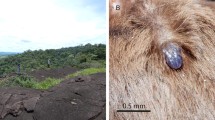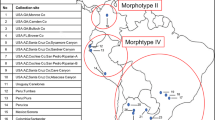Abstract
The fossil record of ticks has been classically used to discern the probable vicariance events of these arthropods, and to date the split moments of the different lineages. Although new techniques based on molecular clock methods are already available, tick fossil record still stands as a valuable source of information if correctly interpreted. Here we report about a male specimen of Ornithodoros (Alectorobius) sp. found in Dominican amber of about 25 millions years, illustrating its main morphological features. We also discuss the findings in a recent paper, which may contain unreliable interpretations on some fossil ticks. We support previous data on the presence of Argasidae in Miocene Dominican amber, and provide comments on the presence of ticks in Burmese amber. We further elaborate on the spread of ticks in the light of the record and description of a new family found in Cretaceous amber.



Similar content being viewed by others
References
Burger TD, Shao R, Beati L, Miller H, Barker SC (2012) Phylogenetic analysis of ticks (Acari: Ixodida) using mitochondrial genomes and nuclear rRNA genes indicates that the genus Amblyomma is polyphyletic. Mol Phylogenet Evol 64(1):45–55
Burger TD, Shao R, Barker SC (2013) Phylogenetic analysis of the mitochondrial genomes and nuclear rRNA genes of ticks reveals a deep phylogenetic structure within the genus Haemaphysalis and further elucidates the polyphyly of the genus Amblyomma with respect to Amblyomma sphenodonti and Amblyomma elaphense. Ticks Tick Borne Dis 4:265–274. https://doi.org/10.1016/j.ttbdis.2013.02.002
Chitimia-Dobler L, Cancian de Araujo B, Ruthensteiner B, Pfeffer T, Dundlop JA (2017) Amblyomma birmitum a new species of hard tick in Burmese amber. Parasitology 144:1441–1448. https://doi.org/10.1017/S0031182017000853
de la Fuente J (2003) The fossil record and the origin of ticks (Acari: Parasitiformes: Ixodidae). Exp Appl Acarol 29:331–344
Guglielmone AA, Robbins RG, Apanaskevich DA, Petney TN, Estrada-Peña A, Horak I (2014) The hard ticks of the world. Springer, Dordrecht, pp 738
Klompen H, Grimaldi D (2001) First Mesozoic record of a parasitiform mite: a larval argasid tick in Cretaceous amber (Acari: Ixodida: Argasidae). Ann Entomol Soc Am 94:10–15
Mans BJ, de Klerk D, Pienaar R, de Castro MH, Latif AA (2012) The mitochondrial genomes of Nuttalliella namaqua (Ixodoidea: Nuttalliellidae) and Argas africolumbae (Ixodoidae: Argasidae): estimation of divergence dates for the major tick lineages and reconstruction of ancestral blood-feeding characters. PLoS ONE 7:e49461
Mans BJ, de Castro MH, Pienaar R, de Klerk D, Gaven P, Genu S, Latif AA (2016) Ancestral reconstruction of tick lineages. Ticks Tick Borne Dis 7:509–535. https://doi.org/10.1016/j.ttbdis.2016.02.002
Peñalver E, Arillo A, Delclòs X, Peris D, Grimaldi DA, Anderson SR, Pérez-de la Fuente R (2017) Ticks parasitised feathered dinosaurs as revealed by Cretaceous amber assemblages. Nat Commun 8:1924
Poinar G (2008) Lutzomyia adiketis sp. n. (Diptera: Phlebotomidae), a vector of Paleoleishmania neotropicum sp. n. (Kinetoplastida: Trypanosomatidae) in Dominican amber. Parasites Vectors 1:22. https://doi.org/10.1186/1756-3305-1-22
Poinar GO (1995) First fossil soft ticks, Ornithodoros antiquus n. sp. (Acari: Argasidae) in Dominican amber with evidence of their mammalian host. Experientia 51(4):384–387
Sands AF, Apanaskevich DA, Matthee S, Horak IG, Harrsion A, Karim S, Mohammed AK, Mumcuoglu KY, Rajakurana RS, Santos-Silva MM, Matthee CA (2017) Effects of tectonics and large scale climatic changes on the evolutionary history of Hyalomma ticks. Mol Phylogenet Evol 114:153–165. https://doi.org/10.1016/j.ympev.2017.06.002
Smejkal GB, Poinar GO, Righetti PG (2009) Will amber inclusions provide the first glimpse of a Mesozoic proteome? Expert Rev Proteom 6:1–4
Venzal JM, Estrada-Peña A, Mangold AJ, González-Acuña D, Guglielmone AA (2008) The Ornithodoros (Alectorobius) talaje species group (Acari: Ixodida: Argasidae): description of Ornithodoros (Alectorobius) rioplatensis n. sp. from southern South America. J Med Entomol 45(5):832–840
Visser JNJ (1995) Post-glacial Permian stratigraphy and geography of southern and central Africa: boundary conditions for climatic modelling. Palaeogeogr Palaeoclimatol Palaeoecol 118:213–243
Author information
Authors and Affiliations
Corresponding author
Rights and permissions
About this article
Cite this article
Estrada-Peña, A., de la Fuente, J. The fossil record and the origin of ticks revisited. Exp Appl Acarol 75, 255–261 (2018). https://doi.org/10.1007/s10493-018-0261-z
Received:
Accepted:
Published:
Issue Date:
DOI: https://doi.org/10.1007/s10493-018-0261-z




